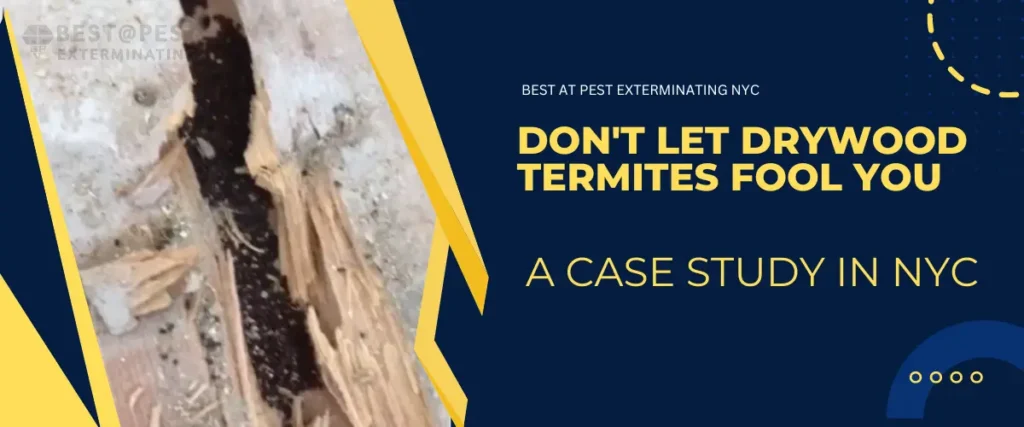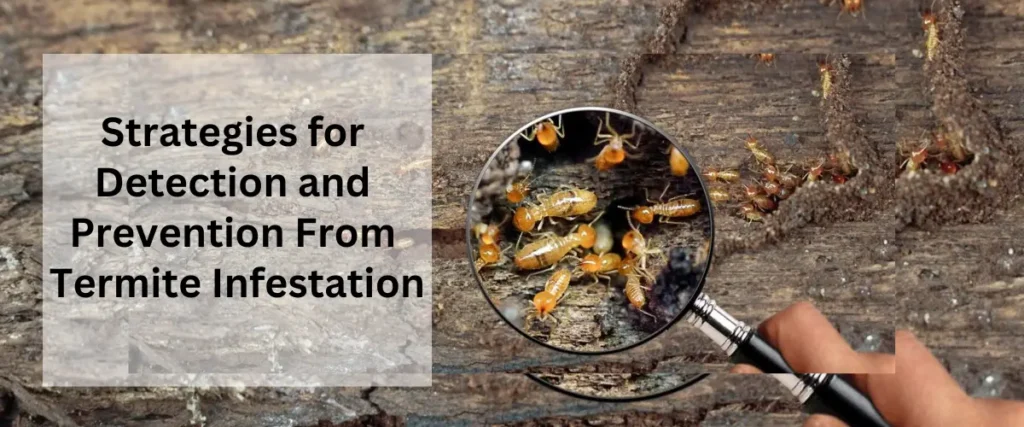
Fortress Guide for Termite Barriers for existing homes and Effective Solutions
For many American homeowners, termites are a constant worry. These silent destroyers can munch away at the structural integrity of your home for years before you even notice a problem. This blog post will serve as your fortress guide to understanding termite barriers, a crucial element in any homeowner’s termite defense plan.
Termite Barriers: Your Home’s Defensive Line
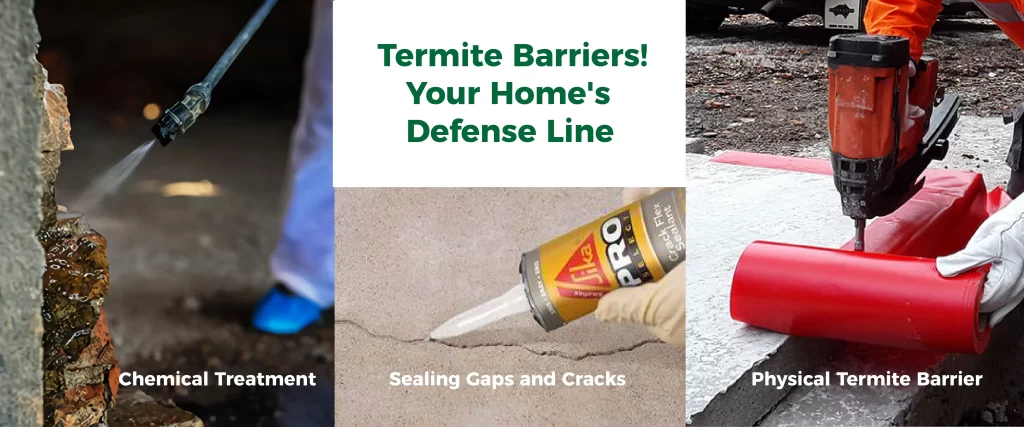
When it comes to protecting an existing home from termite damage, termite barriers are still a crucial defensive measure. Here’s how termite barriers can be implemented for an existing home:
Chemical Treatments:
Professional pest control services can apply liquid termiticides around the perimeter of your home. This creates a chemical barrier that repels or kills termites as they attempt to enter. Regular reapplication may be necessary to maintain effectiveness.
Baiting Systems:
Installing bait stations strategically around the exterior of your home can help monitor and control termite activity. These stations contain termite attractants combined with a slow-acting toxic substance. Termites feed on the bait and carry it back to their colony, gradually eliminating the infestation.
Physical Barriers:
Physical barriers, such as metal termite shields or crushed stone barriers, can be installed around vulnerable areas like foundation walls, plumbing penetrations, and crawl spaces. These barriers create obstacles that termites must navigate around, reducing the likelihood of infestation.
Sealing Cracks and Gaps:
Seal any cracks or gaps in your home’s foundation, walls, and utility entry points. Termites can exploit even tiny openings to gain access to your home, so thorough sealing can help prevent infestations.
Regular Inspections:
Schedule regular termite inspections by a qualified pest control professional. They can identify early signs of termite activity and recommend appropriate treatment or barrier reinforcement measures.
Wood Treatment:
Treat wooden structures in and around your home with termite-resistant chemicals or coatings. This can help deter termites from feeding on the wood and reduce the risk of infestation.
Moisture Control:
Termites are attracted to moisture, so ensure proper drainage around your home’s foundation and fix any leaks promptly. Keeping the soil around your home dry can make it less hospitable to termites.
Does Chlorine Kill Termites?: Myth vs. Reality
Chlorine, in the form of household bleach, is often a suggested DIY remedy for termite infestations. However, the reality is that bleach is not an effective solution for termite control. Here’s a breakdown:
Myth: Chlorine (bleach) kills termites and eliminates the colony.
Reality: Bleach can kill termites on direct contact, but that’s a minor victory. Termite colonies reside deep underground (subterranean termites) or within the wood itself (drywood termites). Bleach can’t reach these areas and eliminate the entire colony.
Here’s why using bleach for termites is a bad idea:
- Ineffective for the colony: As mentioned, bleach doesn’t target the source of the problem – the nest.
- Damages property: Bleach is corrosive and can harm your foundation, pipes, and other structures.
- Potential health risks: Bleach fumes can be hazardous, and improper handling can cause skin irritation or respiratory problems.
Safety Considerations and Proper Application Methods
Termite barrier applications, especially those using chemicals, require precautions to ensure the safety of yourself, your family, and pets. Here’s what to keep in mind:
- Chemical Hazards: Many termite barrier products contain insecticides that can be harmful if mishandled. Always read and follow the manufacturer’s instructions on the product label.
- Protective Gear: Wear appropriate personal protective equipment (PPE) during application. This may include gloves, eye protection, long-sleeved clothing, and a respirator (depending on the product).
- Children and Pets: Keep children and pets away from the application area during and after treatment until it has dried according to the label instructions.
- Ventilation: Ensure proper ventilation during and after application. Open windows and doors to allow fumes to escape.
Proper Application Methods for Termite Barriers
There are two main types of termite barriers: soil treatments and termite baiting systems. Each has its own application method:
Soil Treatment:
- Professional application is highly recommended: Termite control products can be complex and require proper licensing for application.
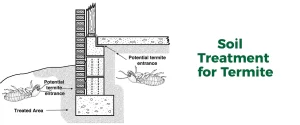
Soil treatment for termite - Trenching: In some cases, a professional may create a trench around the foundation of your home and fill it with the termiticide.
- Rodding: Alternatively, they may inject the termiticide into the soil around the foundation through small holes drilled at specific intervals.
- Broadcast application: For some products, a surface application around the foundation may be sufficient.
Termite Baiting Systems:
- Bait stations are placed strategically around the foundation of your home, both inside and outside.
- These stations contain a slow-acting bait that termites consume and share with others in the colony, ultimately eliminating it.
- Regular monitoring by a pest control professional is necessary to ensure the effectiveness of the baiting system.
Dealing with Termites in Fences: The Outer Line of Defense
While termite barriers focus on protecting your home’s foundation, it’s important not to forget your property’s outer perimeters, especially wooden fences. This section will equip you to identify and combat termite threats in your fence:
Common signs of termite infestation in fences:
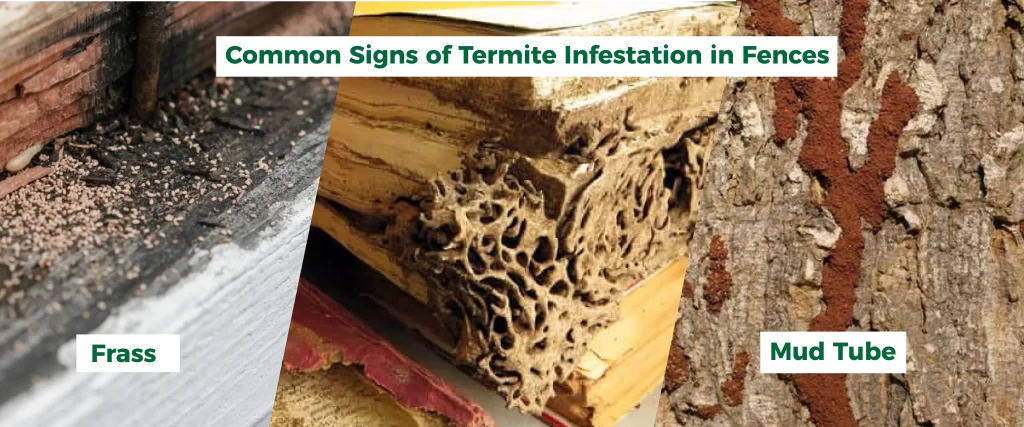
- Visible Damage: Look for hollowed-out or damaged wood. Termites consume wood from the inside out, leaving a thin veneer of timber or paint on the surface.
- Mud Tubes: Termites build mud tubes, pencil-sized tunnels made of soil, wood particles, and saliva, to travel between the ground and the wood they’re infesting. These tubes often appear along the exterior of fences.
- Discarded Wings: After swarming, termites shed their wings. If you notice piles of discarded wings near your fence, it could indicate a termite presence.
- Frass: Termite droppings, known as frass, resemble small piles of sawdust or wood pellets. You may find them accumulating near the base of your fence or within crevices.
- Blistering or Bubbling Paint: Termites can cause moisture buildup within the wood, leading to paint that appears blistered or bubbling on the surface.
- Sagging or Buckling Wood: As termites weaken the structural integrity of wood, fences may start to sag, buckle, or appear uneven.
- Tapping Sounds: If you tap on wood near the infested area and hear a hollow sound, it could indicate termite damage.
Strategies for preventing and treating termite damage in wooden fences:
Here are some key strategies to stop termites before they become a problem for your wooden fence:
Eliminate Moisture Sources:
Termites thrive in moist environments. Minimize moisture around your fence by:
- Fixing leaky faucets or sprinklers that might keep the soil damp near the fence posts.
- Ensuring proper drainage around the fence line to prevent water from pooling.
- Maintaining a gap between the fence and vegetation like bushes or trees. This prevents direct contact and reduces humidity.
Reduce Wood-to-Soil Contact:
Termites easily enter fences through contact with the ground. Here’s how to create a barrier:
- Use pressure-treated wood for your fence. This wood is infused with chemicals that deter termites.
- If using untreated wood, consider installing a physical barrier like crushed gravel or metal flashing between the bottom of the fence post and the soil.
- Maintain a minimum clearance of a few inches between the bottom of the fence and the ground.
Regular Maintenance and Inspections:
Regularly inspect your fence for signs of termite activity:
- Look for mud tubes on the wood, which are termite shelter trails.
- Tap the wood for hollow sounds, which can indicate termite damage within.
- Check for piles of termite droppings (frass) that resemble sawdust.
Additional Preventative Measures:
- Consider using termite-resistant wood like redwood, cedar, or juniper for your fence (although pressure-treated wood is generally more affordable).
- Apply a termiticide barrier around the base of the fence posts. Note: This should only be done by a licensed pest control professional due to safety concerns and potential regulations regarding outdoor pesticide use.
Treating Termite Damage in Wooden Fences:
If you discover a termite infestation in your fence, here are your options:
Contact a licensed pest control professional: They have the expertise and tools to safely and effectively eliminate the termites using methods like:
- Termite baiting systems: These stations lure and kill termites slowly, disrupting the colony.
- Soil treatment: A termiticide is applied to the soil around the fence posts to create a barrier.
DIY Treatment (for small infestations): For minor cases, you can try:
- Spot treatment: Apply a termiticide directly to affected areas of the fence. Important: Only use products labeled for termites and follow all safety instructions carefully.
- Physical removal: If the damage is localized, you might be able to remove the affected wood section and replace it with termite-resistant material.
Does Permethrin Kill Termites? Examining a Common Weapon
Yes, Permethrin is one of the most common and effective chemicals used for termite extermination. It’s a synthetic pyrethroid insecticide, which means it works by affecting the nervous system of insects, including termites.
When termites come into contact with permethrin, it disrupts their nerve signals, ultimately leading to death. Permethrin is available in a variety of formulations, including liquids, dusts, and foams.
It can be applied to the soil around your home, injected into cracks and crevices, or used to create a barrier treatment around your foundation.
Here are some of the benefits of using permethrin for termite control:
- Effective: Permethrin is a very effective insecticide that can kill termites on contact.
- Relatively safe: Permethrin is relatively safe for humans and pets when used according to the label.
- Affordable: Permethrin is one of the more affordable termite control options.
However, there are also some drawbacks to consider:
- Not long-lasting: Permethrin does not have a long-lasting residual effect, so it may need to be reapplied every few months or after heavy rains.
- Doesn’t eliminate the colony: Permethrin only kills termites that come into contact with it. It will not eliminate the entire termite colony.
- Not a DIY solution: Permethrin can be dangerous if not used properly. It is important to have a qualified pest control professional apply permethrin for termite control.
Safeguarding Potted Plants from Termites: An Unexpected Threat
Termites, those wood-chomping menaces, might not be the first pest that comes to mind when thinking about your potted plants. But believe it or not, these destructive insects can pose a surprising threat to your container garden.

Here’s why you need to be vigilant:
- Moist haven: Termites are drawn to moisture, and potted plants often create pockets of damp soil around them, especially during summer. This can be a welcome invitation for termites seeking new territory.
- Direct access: Unlike in-ground plants, potted plants sitting directly on soil are easily accessible to subterranean termites. They can crawl right up the pot and into the root system.
- Woody treats: While termites typically target wood, some species will happily munch on the woody stems or roots of certain potted plants.
Fortress for Your Foliage: How to Safeguard Your Potted Plants
Don’t despair! Here are some steps you can take to keep your potted plants safe from termites:
- Physical barriers: Elevate your pots off the ground. Placing them on pot saucers or stands creates a physical barrier that makes it harder for termites to reach them.
- Potting mix matters: Use a well-draining potting mix. This helps prevent excess moisture buildup that attracts termites.
- Watering wisely: Water your plants deeply but infrequently, allowing the soil to dry out somewhat between waterings.
- Botanical bodyguards: Consider planting natural termite repellents like marigolds or margosa trees near your potted plants.
- Beneficial buddies: Introducing beneficial nematodes, microscopic worms that prey on termites, can be a natural way to control termite populations around your potted plants.
- Inspect regularly: Regularly inspect your plants for signs of termite damage, such as wilting, hollowed stems, or mud tubes on the pot.
By implementing these termite barrier strategies, you can fortify your property against termite infestations and protect your investment from costly damage. Regular maintenance and vigilant monitoring are key to ensuring the continued effectiveness of these barriers.

